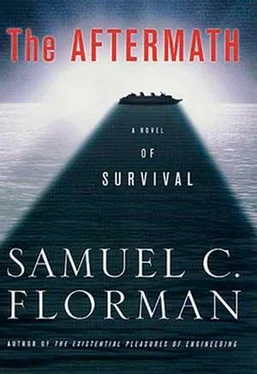Samuel Florman - The Aftermath
Здесь есть возможность читать онлайн «Samuel Florman - The Aftermath» весь текст электронной книги совершенно бесплатно (целиком полную версию без сокращений). В некоторых случаях можно слушать аудио, скачать через торрент в формате fb2 и присутствует краткое содержание. Город: New York, Год выпуска: 2001, ISBN: 2001, Издательство: Thomas Dunne books, Жанр: sf_postapocalyptic, на английском языке. Описание произведения, (предисловие) а так же отзывы посетителей доступны на портале библиотеки ЛибКат.
- Название:The Aftermath
- Автор:
- Издательство:Thomas Dunne books
- Жанр:
- Год:2001
- Город:New York
- ISBN:0-312-26652-9
- Рейтинг книги:5 / 5. Голосов: 1
-
Избранное:Добавить в избранное
- Отзывы:
-
Ваша оценка:
- 100
- 1
- 2
- 3
- 4
- 5
The Aftermath: краткое содержание, описание и аннотация
Предлагаем к чтению аннотацию, описание, краткое содержание или предисловие (зависит от того, что написал сам автор книги «The Aftermath»). Если вы не нашли необходимую информацию о книге — напишите в комментариях, мы постараемся отыскать её.
The Aftermath — читать онлайн бесплатно полную книгу (весь текст) целиком
Ниже представлен текст книги, разбитый по страницам. Система сохранения места последней прочитанной страницы, позволяет с удобством читать онлайн бесплатно книгу «The Aftermath», без необходимости каждый раз заново искать на чём Вы остановились. Поставьте закладку, и сможете в любой момент перейти на страницу, на которой закончили чтение.
Интервал:
Закладка:
“Can you folks shed any light on this?” asked the captain, turning to the Frosts.
“I think we can,” said Richard with a wry smile. “Mr. McIntosh may have been all over the world, but he obviously has never been to Madagascar. It’s that big island to the east, just two hundred fifty miles away, as Captain Nordstrom said. But even though it’s just a stone’s throw away geographically, it’s light-years away in racial, cultural, and historical terms. Most of the residents of that island are what we call Malayo-Indonesians or Austronesians, and yes indeed, they came originally from Indonesia. Actually, if you go far enough back, we believe their forebears came from the South China coast around 3500 B.C., migrated through Taiwan and the Philippines, and arrived in Indonesia and the Malaysian peninsula about two thousand years later. Presumably they traveled those vast distances in double-outrigger sailing canoes. Eventually, they continued to expand to the east, occupying much of what we call Polynesia; and then, much later, some of them turned around and traveled to the southwest, arriving in Madagascar about A.D. 500. The language spoken today on Madagascar is very similar to the language spoken on Borneo, over four thousand miles away across the open Indian Ocean.”
“A scientist friend of ours,” Deborah Frost interjected, “whose specialty is prehistoric migrations, has said that this circumstance strikes him as—and I think I can quote him exactly—’the most astonishing fact of human geography in the entire world.’ Of course,” she continued, “you do see black African features among some of the population of Madagascar. These two shores being so close to each other, it could hardly be otherwise. But I believe that most of these darker people lived in the coastal lowlands, where they would have succumbed to’ the tsunamis. If your pirates looked like Malaysians, you’re neither dreaming nor confused. Obviously, they come from Madagascar.”
“Let’s not forget,” Richard said, “that Jane Warner’s calculated safety zone includes the southern portion of Madagascar as well as our small slice of Africa. It stands to reason that there are survivors on that island, and maybe more than a few. It’s a big island, you know, almost a thousand miles long. Of course, if just the southern tip was spared, those folks could be very hard up for food, since that part of the island is famous for its so-called spiny forest, lots of fascinating cactuslike trees, but not great for agriculture. And if they’re desperate, that could explain the pirate crew. Otherwise, that part of the story doesn’t ring true. The inhabitants of Madagascar, I would say, are as pleasant and easygoing a people as you’ll find anywhere in the world.”
“What’s all that stuff about King Radama and Queen What’s-her-name?” asked Dr. Hardy. “Does that make any sense?”
“Oh yes, it does indeed,” Deborah said. “It’s all part of the island’s history, which is as extraordinary as its prehistoric origins. Richard told you that the native population arrived on the island around A.D. 500. The ruins of Arab settlements have been found dating from about 1200, and the Portuguese first stopped by for a visit in 1500. During the following couple of hundred years, although there were occasional attempts to establish European settlements, they were frustrated by disease and hostile natives. So a civilization developed in relative isolation, a historical backwater, largely ignored by Westerners. A number of separate tribes evolved, but by the end of the eighteenth century, most of these were united under one ruler.
“This king—whose name I don’t remember, and you don’t want to know since it has about twenty letters—had a son and successor called King Radama I. There you are with the name of your pirate ship. Radama extended his rule over practically all of the island. In this effort he was helped by the British, who had become interested in this vast landmass adjoining their trade routes to India. From England the king received arms and advisers, and, as an incidental adjunct, an influx of Christian missionaries.
“When Radama died in the early 1800s, he was succeeded by his widow, Queen Ranavalona I. Known to some as ‘the wicked queen,’ she determined to rid the land of European and Christian influence. During her lengthy rule, she drove out the missionaries, martyring a number of them, and also brutalized her own people. She was one rough, tough lady. Make of this what you will in trying to figure out what your pirate queen is up to.”
“Incidentally, Wilson,” Richard Frost said, “you and your fellow engineers would be fascinated to learn about one European who, because of his technological talents, managed to get into the queen’s good graces. Jean Laborde, the son of a French blacksmith, was shipwrecked off the coast of Madagascar in the 1830s. Brought before the queen, he convinced her that he could manufacture all manner of things she craved—particularly muskets and gunpowder. Whereupon she provided him with work crews to build what amounted to an industrial complex. He was as good as his word, and better. In a large factory compound he produced munitions, bricks and tiles, pottery, glass, porcelain, soap, candles, cement, dyes, sugar, rum—just about everything needed to make the island self-sufficient. He was eventually expelled for dabbling in local politics, and his workforce, who had labored without pay, wrecked the factory buildings and machines. That was the end of Madagascar’s industrial revolution.”
“Sounds like someone we could use today,” Dr. Hardy said.
“There’s a lot I can tell you,” Richard continued, “but I don’t know how much more you want to hear. The French entered the picture in 1883, when they invaded the island. They came again in 1895 and stayed, making the place a French colony. The monarchy was declared at an end, and Queen Ranavalona III was exiled to Algeria. During World War II, the British attacked in order to drive out the Vichy French, which they did. After the war, with French control restored, the natives rebelled, were bloodily repressed, and eventually, in 1960, achieved independence. Subsequent experiments in government were chaotic, to put it mildly. I think that’s enough history for your purposes.”
“Where does Captain Kidd fit into the picture?” Captain Nordstrom asked.
“Ah yes, the pirates.” Deborah Frost warmed to the subject. “They’re a very important part of the saga of Madagascar. From the 1680s to around 1720, the island was a major hideout for pirates in the Indian Ocean. They preyed upon the merchant ships that carried rich cargoes to and from India and the Near East. At one time the pirate population numbered nearly a thousand. And to be sure, William Kidd—Captain Kidd—was among them. As a matter of fact, it was in the Indian Ocean, at that time, that Kidd first decided to become a pirate.
“This was a mysterious turnabout, since he had been sent there by the British Crown to apprehend pirates who were molesting the ships of the East India Company. Just as, earlier, he had been commissioned by both New York and Massachusetts to protect the American coast from buccaneers. After he was hanged in London—in 1701, I think it was—doubts were expressed about the fairness of his trial. Maybe there are questions of guilt and innocence that appeal to your so-called pirate queen.”
Hardy and Nordstrom had heard more than enough historical detail; but the young scribe, Wil Hardy, was lapping it up. A thousand pirates! Captain Kidd! An island where the natives speak like the people of Borneo, four thousand miles away! Evil queens martyring missionaries! What a delicious concoction of exotica for a young historian, and for a young mind that had absorbed comic books and movie special effects and computer games. All in addition to the flora and fauna of Madagascar—tens of thousands of species unique to the island, notably more than thirty different kinds of lemurs—about which his friend Roxy had been reading, and waxing rhapsodic, ever since they learned that a part of the island was in Jane Warner’s safety zone.
Читать дальшеИнтервал:
Закладка:
Похожие книги на «The Aftermath»
Представляем Вашему вниманию похожие книги на «The Aftermath» списком для выбора. Мы отобрали схожую по названию и смыслу литературу в надежде предоставить читателям больше вариантов отыскать новые, интересные, ещё непрочитанные произведения.
Обсуждение, отзывы о книге «The Aftermath» и просто собственные мнения читателей. Оставьте ваши комментарии, напишите, что Вы думаете о произведении, его смысле или главных героях. Укажите что конкретно понравилось, а что нет, и почему Вы так считаете.












